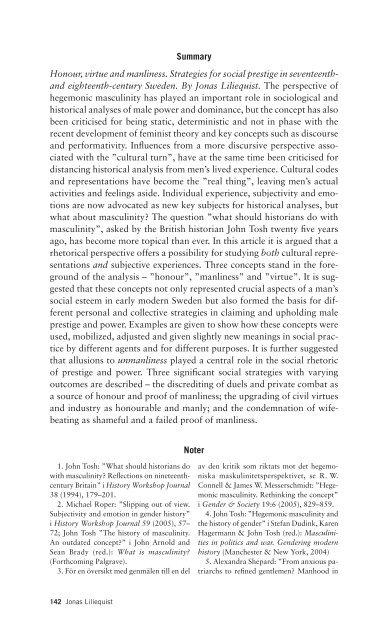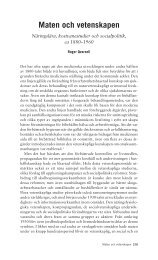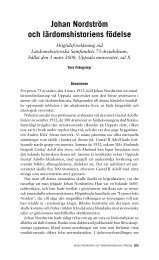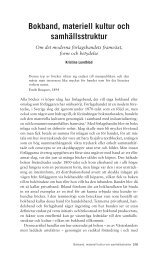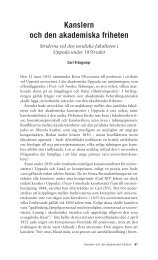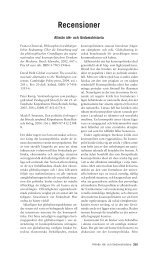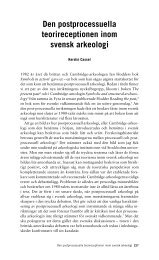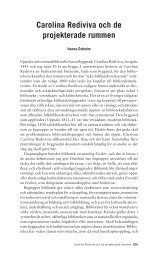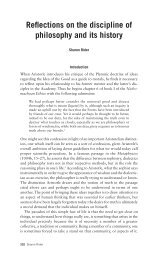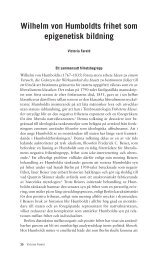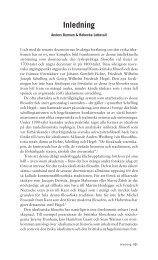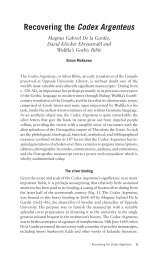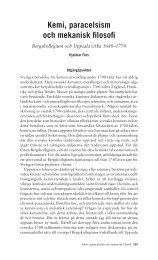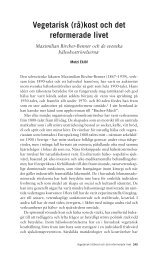Ära, dygd och manlighet
Ära, dygd och manlighet
Ära, dygd och manlighet
You also want an ePaper? Increase the reach of your titles
YUMPU automatically turns print PDFs into web optimized ePapers that Google loves.
142 Jonas Liliequist<br />
Summary<br />
Honour, virtue and manliness. Strategies for social prestige in seventeenth-<br />
and eighteenth-century Sweden. By Jonas Liliequist. The perspective of<br />
hegemonic masculinity has played an important role in sociological and<br />
historical analyses of male power and dominance, but the concept has also<br />
been criticised for being static, deterministic and not in phase with the<br />
recent development of feminist theory and key concepts such as discourse<br />
and performativity. Influences from a more discursive perspective associated<br />
with the ”cultural turn”, have at the same time been criticised for<br />
distancing historical analysis from men’s lived experience. Cultural codes<br />
and representations have become the ”real thing”, leaving men’s actual<br />
activities and feelings aside. Individual experience, subjectivity and emotions<br />
are now advocated as new key subjects for historical analyses, but<br />
what about masculinity? The question ”what should historians do with<br />
masculinity”, asked by the British historian John Tosh twenty five years<br />
ago, has become more topical than ever. In this article it is argued that a<br />
rhetorical perspective offers a possibility for studying both cultural representations<br />
and subjective experiences. Three concepts stand in the foreground<br />
of the analysis – ”honour”, ”manliness” and ”virtue”. It is suggested<br />
that these concepts not only represented crucial aspects of a man’s<br />
social esteem in early modern Sweden but also formed the basis for different<br />
personal and collective strategies in claiming and upholding male<br />
prestige and power. Examples are given to show how these concepts were<br />
used, mobilized, adjusted and given slightly new meanings in social practice<br />
by different agents and for different purposes. It is further suggested<br />
that allusions to unmanliness played a central role in the social rhetoric<br />
of prestige and power. Three significant social strategies with varying<br />
outcomes are described – the discrediting of duels and private combat as<br />
a source of honour and proof of manliness; the upgrading of civil virtues<br />
and industry as honourable and manly; and the condemnation of wifebeating<br />
as shameful and a failed proof of manliness.<br />
1. John Tosh: ”What should historians do<br />
with masculinity? Reflections on nineteenthcentury<br />
Britain” i History Workshop Journal<br />
38 (1994), 179–201.<br />
2. Michael Roper: ”Slipping out of view.<br />
Subjectivity and emotion in gender history”<br />
i History Workshop Journal 59 (2005), 57–<br />
72; John Tosh ”The history of masculinity.<br />
An outdated concept?” i John Arnold and<br />
Sean Brady (red.): What is masculinity?<br />
(Forthcoming Palgrave).<br />
3. För en översikt med genmälen till en del<br />
Noter<br />
av den kritik som riktats mot det hegemoniska<br />
maskulinitetsperspektivet, se R. W.<br />
Connell & James W. Messerschmidt: ”Hegemonic<br />
masculinity. Rethinking the concept”<br />
i Gender & Society 19:6 (2005), 829–859.<br />
4. John Tosh: ”Hegemonic masculinity and<br />
the history of gender” i Stefan Dudink, Karen<br />
Hagermann & John Tosh (red.): Masculinities<br />
in politics and war. Gendering modern<br />
history (Manchester & New York, 2004)<br />
5. Alexandra Shepard: ”From anxious patriarchs<br />
to refined gentlemen? Manhood in


